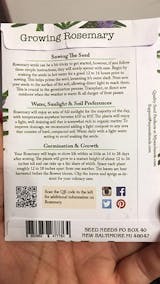Description
Calling to mind the sea mist along the coastal cliffs of its native Mediterranean region that it is named for, Rosmarinus officinalus, or rosemary, is a versatile addition to your herb garden or yard. Easily growing to heights of 12 to 36 inches tall, and almost 3 feet wide, rosemary can make a beautiful hedge to set off your property lines, or you can grow it in containers that can be easily moved indoors in the coldest temperatures. With its crisp, pleasant odor, it is also the perfect border to sidewalks and walkways, releasing its fragrance when brushed in passing.
Rosemary has woody stems, gray-green needle-like leaves and bright blue flowers that last throughout the spring and summer. The plant grows slowly during its first year, but it will take off during the second. Like its relatives in the Lamiaceae (mint) family, it can become invasive if you don't use it often or prune it to keep it under control.
The plant requires no winter protection in USDA Hardiness Zones 8 and farther south; in northern zones, you can move the container-grown plants indoors. Rosemary is easy to grow, although it can be vulnerable to whiteflies, spider mites, scale, mealybug, powdery mildew and root rot.
Not only is rosemary a visually appealing and wonderfully fragrant plant in the garden, it has multiple uses in the kitchen and in herbal medicines, as well as being a traditional component of festival and wedding decorations, designed to ward off evil influences. Season meats and poultry, sauces, soups, and stews with the herb. Mix it with sea salt and a good-quality, fruity olive oil for a delicious bread dip, or combine it with oil, garlic, salt, pepper and balsamic vinegar for an outstanding marinade for meats, poultry or vegetables.
Herbal medicine practitioners also recommend rosemary as a good source of iron, calcium and Vitamin B6. It is also used to improve memory, relieve muscle aches, boost the immune system and even to help promote hair growth.

























